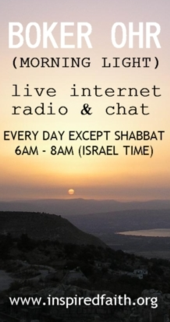Written by David Bivin
More articles by
David Bivin can be read at
Jerusalem Perspective
A
careful reading of the New Testament suggests that
Jesus was a scholar learned in the Scriptures and
religious literature of the period, which was vast and
varied. Yet the popular view of Jesus is that he was a
simple, uneducated character from the provinces. This
misunderstanding is due in part to a number of
disparaging statements made about Nazareth and the
Galilee such as, "Nazareth! Can anything good come
from there?" (Jn. 1:46), and "Utterly amazed, they
asked: 'Are not all these men who are speaking
Galileans?'" (Acts 2:7).
These statements may reflect a Judean bias against
Galileans. Some Judeans may have seen themselves as
cultured and cosmopolitan. To them, the Galileans were
provincials whose accent seemed coarse and unrefined.
Actually, however, the reverse may have been true: the
Galileans were the more exposed to the outside world
while the Judeans, living in the interior of the land,
were partially sheltered from contact with foreign
nations. The Galilee also was more urban, with many
developed villages. Judea, by contrast, was generally
more rural in character.
No
doubt this same disdain toward Galileans prompted the
assumption, preserved in John 7:15, that Jesus had no
education: "The Jews were amazed and asked, 'How did
this man get such learning without having studied?'"
Conservative Galileans
Such passages have given rise to the idea that Jesus
and his disciples were uneducated simply because they
came from Galilee. Surprisingly, however, the standard
of education and religious training in Galilee
surpassed that of Judea.
According to Shmuel Safrai, Hebrew University
Professor of Jewish History of the Mishnaic and
Talmudic Periods, not only do the number of
first-century Galilean sages exceed the number of
Judean sages, but the moral and ethical quality of
their teaching is still considered more highly than
that of their Judean counterparts. Such first-century
Galilean sages as Yohanan ben Zakkai, Hanina ben Dosa,
Abba Yose Holikofri of Tiv'on, Zadok and Jesus of
Nazareth helped impart a deep understanding of the
Torah to the residents of Galilee.
In
addition to their high level of knowledge of and
reverence for Scripture, the Galileans could be seen
as the religious conservatives of the period. Jewish
messianic nationalism flourished in the Galilee. Judah
the Galilean, for example, was the founder of the
"Zealots" movement, and it was in Galilee, not Judea,
that the great revolt against Rome broke out in 66
A.D.
Early Training
The New Testament says almost nothing about Jesus'
life from after his birth until he appeared in the
temple at age twelve, and from then until he began his
public ministry at about the age of thirty. Yet a good
indication of what a young Jewish man in Jesus' day
would have been doing may be found in Avot 5:21, a
tractate from a collection of rabbinic sayings called
the Mishnah, which states:
At
five years of age, one is ready for the study of the
Written Torah, at ten years of age for the study of
the Oral Torah, at thirteen for bar mitzvah [the
religious coming-of-age ceremony], at fifteen for the
study of halachot [rabbinic legal decisions], at
eighteen for marriage, at twenty for pursuing a
vocation, at thirty for entering one's full vigor...
Although this statement cannot be dated with
certainty, and may come some 100 years after the time
of Jesus, there are many other passages in rabbinic
works that indicate the importance placed upon the
education of children and provide some insight into
how the young Jesus was probably spending his time.
Certainly education was highly valued in Jewish
society. In his apology for Judaism, Against Apion,
written to counter anti-Semitism, the first-century
Jewish historian Josephus states:
Above all we pride ourselves on the education of our
children, and regard as the most essential task in
life the observance of our laws and of the pious
practices based thereupon, which we have inherited.
(Against Apion 1:60, Loeb ed.)
The Talmud even suggests the preferred class size:
The
maximum number of elementary pupils that should be
placed under one teacher is twenty-five; if there are
fifty, an additional teacher must be provided; if
there are forty, a senior student should be engaged to
assist the teacher. (Bava Batra 21a)
High Standard of Education
A synagogue in the first century usually had its own
bet SE·fer (elementary school) and bet mid·RASH
(secondary school) in which children and adults
studied Torah and the oral traditions. Formal
education ended at the age of twelve or thirteen when
most children went to work. The more gifted students
who so desired could continue their studies at the bet
mid·RASH together with adults who studied in their
spare time.
A
few of the most outstanding bet mid·RASH students
eventually left home to study with a famous sage,
being encouraged and sometimes supported by their
families. Only the very promising students were urged
to continue studying since their assistance was
usually needed in agricultural work at home (Shmuel
Safrai, "Education and the Study of Torah," The Jewish
People in the First Century 2:953).
One
might assume that the synagogue, as the place of
worship, would be considered more important or more
sacred than the schools, but this was not the case. To
this day the bet mid·RASH is given more prominence
than the synagogue — not because education is valued
more highly than worship, but because Judaism does not
make a distinction between the two. Indeed, Judaism
has always held that study of Torah is one of the
highest forms of worship (cf. Babylonian Talmud,
Shabbat 30a).
Diligent Study
Jewish tradition contains many statements enjoining
continued and diligent study, such as the Mishnah
passage, "Discipline yourself to study Torah, for you
do not acquire it by inheritance" (Avot 2:12). This
point of view is echoed throughout the New Testament
in such passages as the following:
[The Jews of Berea] were more noble…examining the
Scriptures daily to see if these things were so. (Acts
17:1)
Do your best to win God's approval as a workman who
does not need to be ashamed, because he knows how to
interpret the word of truth correctly. (2 Tim. 2:15)
Make every effort to add to your faith goodness, and
to goodness, knowledge.... (2 Pet. 1:5)
Memorization
Although scrolls were used for reading and study and
the practice of writing was highly developed, written
material was expensive because all manuscripts had to
be hand-copied by trained scribes. Scrolls, therefore,
were relatively scarce, and even though in Jesus' time
every Jewish home had at least one of the
approximately twenty biblical scrolls, few people had
immediate access to more than a very small part of the
entire library of sacred literature. Learning,
consequently, involved a great deal of memorization.
Professor Safrai has written concerning educational
methods of the period:
Individual and group study of the Bible, repetition of
the passages, etc., were often done by chanting them
aloud. There is the frequent expression, "the chirping
of children," which was heard by people passing close
by a synagogue as the children were reciting a verse.
Adults too, in individual and group study, often read
aloud; for it was frequently advised not to learn in a
whisper, but aloud. This was the only way to overcome
the danger of forgetting. (The Jewish People in the
First Century 2:953)
In the eyes of the sages, repetition was the key to
learning, as these passages illustrate:
A
person who repeats his lesson a hundred times is not
to be compared with him who repeats it a hundred and
one times. (Babylonian Talmud, Hagigah 9b)
If [the student] learns Torah and does not go over it
again and again, he is like a man who sows without
reaping. (Babylonian Talmud, Sanhedrin 99a)
Many methods were used to assist the student in
memorizing his lessons, and one passage in the Talmud
(Babylonian Talmud, Shabbat 104a) even describes in
detail the mnemonic devices employed to teach small
children the Hebrew alphabet. Elementary school
students, who studied seven days a week, were given no
new material on the Sabbath, but rather used that time
to memorize material learned earlier in the week (The
Jewish People in the First Century 2:954).
Students enjoyed memorizing their lessons while
strolling outdoors, but they were tempted to shift
their attention to the surrounding scenery. The
Mishnah specifically warns against this:
A
person walking along the road repeating his lessons
who interrupts his memorization and exclaims: "What a
beautiful tree!" or "What a beautiful field!" it is
imputed to him as if he were guilty of a crime
punishable by death. (Avot 3:8)
Such peripatetic memorization is still practiced today
in the Middle East, and is the foundation of the
Muslim system of education. In the Arab world one
frequently can see young men walking back and forth
along the roads at the outskirts of villages and
towns, apparently talking to themselves. They actually
are repeating and memorizing their lessons.
Jesus' Contemporaries
From accounts found in Jewish sources such as those
referred to above, one can form a reasonably accurate
picture of what Jesus was doing in his childhood and
adolescence. He was studying, committing to memory
large amounts of material — Scripture and commentary
on Scripture — all the available sacred literature of
the day.
This was exactly what most of the other Jewish boys of
Jesus' day were doing. The memorization of Written and
Oral Torah was such a large part of Jewish education
that most contemporaries of Jesus had large portions
of this material — at the least almost all of the
Scriptures — firmly committed to memory. As Professor
Safrai has stated:
The
Scriptures were known almost by heart by everyone.
From quite early in the Second Temple period, one
could hardly find a little boy in the street who
didn't know the Scriptures. According to Jerome
(342-420 A.D.) who lived in Bethlehem and learned
Hebrew from local Jewish residents in order to
translate the Scriptures into Latin [producing the
Vulgate Bible]: "There doesn't exist any Jewish child
who doesn't know by heart the history from Adam to
Zerubbabel [i.e., from the beginning to the end of the
Bible]." Perhaps this was a bit of an exaggeration on
Jerome's part, but in most cases his reports have
proved reliable. (Safrai, lecture on June 5, 1985)
Used with permission. Courtesy of Jerusalem
Perspective Online.
Copyright 1987 - 2006
Jerusalem Perspective.
All rights reserved.



